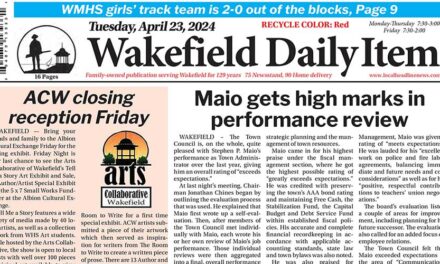Published in the October 27, 2016 edition.
By MARK SARDELLA
WAKEFIELD – Starting next year, Wakefield Public Schools will screen students for substance abuse disorder using a verbal screening tool, as required under the provisions of an opioid abuse prevention bill passed by the Massachusetts legislature and signed into law by Gov. Charlie Baker last March.
Director of Athletics, Health and Wellness Brendan Kent and the town’s Substance Abuse Prevention Coordinator Catherine Dhingra appeared before the School Committee this week to talk about the screenings that will go into effect in the 2017-2018 school year.
By way of introduction, School Superintendent Dr. Kim Smith briefed the School Committee on the provisions of the law that applies to schools.
Smith said that the law requires schools to include a module on the science related to addiction and addictive substances, including the impact of psychoactive substances on the brain and the effect of such substances on a person while operating a motor vehicle. Smith said that Kent has already made sure that the grade nine curriculum covers those topics in the way that the law requires.
Smith said that the law also requires school systems to have a policy on substance abuse prevention and the education of its students on the dangers of substance abuse. Smith said that the School Committee’s policy subcommittee has updated the district’s policies on substance abuse and addiction to make sure that those were in line with the law.
Another provision of the law, Smith said, requires schools to include education about opioid use and misuse during concussion safety training.
Smith said that that the foregoing three requirements are already in place in Wakefield and are in effect this year.
The remaining provision on screening, Smith said, is one that all districts in the state are currently working on in preparation for implementation next year.
The law requires schools to use a “verbal screening tool” to screen students for substance abuse disorder annually at two different grade levels. Smith noted that most schools are looking at one middle school grade and one high school grade.
Smith said that parents/guardians must be notified of the screening at the beginning of the school year and may choose to opt out at any time prior to or during the screening. Screening results, redacted for confidentiality, must be reported to the state Department of Public Health within 90 days of the screening.
Smith said that she is working with other school superintendents in the Middlesex League to make sure everyone is on the same page and they are approaching this together.
Smith turned to Kent and Dhingra to talk about the screening process.
Dhingra described the “motivational interview tool” that will be used when verbally screening students. Screeners will be trained in the skills needed to use the tool, which she said would most likely be “CRAFFT” screening tool.
Kent explained that CRAFFT is a mnemonic acronym of first letters of key words in the six screening questions:
C – Have you ever ridden in a CAR driven by someone (including yourself) who was “high” or had been using alcohol or drugs?
R – Do you ever use alcohol or drugs to RELAX, feel better about yourself, or fit in?
A – Do you ever use alcohol/drugs while you are by yourself, ALONE?
F – Do you ever FORGET things you did while using alcohol or drugs?
F – Do your family or FRIENDS ever tell you that you should cut down on your drinking or drug use?
T – Have you gotten into TROUBLE while you were using alcohol or drugs?
Kent said that the consensus of the discussions in Wakefield was not to bring in an outside agency to conduct the screenings but rather to have trusted adults like guidance counselors or school nurses interview the students.
Dhingra said that if a student is not abusing substances, the screening serves as a positive reinforcement tool. If the screening reveals signs of risky behavior, the next step can range from a longer conversation about the risks of substance abuse to referral to appropriate local services.
Smith said that the screeners will be trained to ask the questions in a motivational manner that’s comfortable for the student and is designed produce the most valid and reliable results.
In a related matter, School Committee member Ann Danehy asked Dhingra a question related to the latest Youth Risk Behavior Survey (YRBS).
Danehy noted that only 48 percent of Wakefield Memorial High School students surveyed perceived smoking marijuana as harmful – lower than the perceived risk of drinking (73 percent), prescription drug use (89 percent) smoking cigarettes (87 percent) and using e-cigarettes (52 percent).
Dhingra said that the student perception of risk for marijuana use is the YRBS category where the biggest change has been seen since 2012, with the perception of risk steadily declining.




